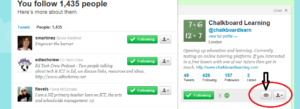There has been a fair level of debate online as well as around the water cooler in staff rooms about whether or not is breaching your professional relationship with your students if you are friends with them on Facebook or follow them on twitter. The argument generally revolves around the following 3 thoughts…
Why you shouldn’t friend or follow students:
- They can access details about your personal life
- You have a direct link to be able to privately communicate with the student, opening up the opportunity for inappropriate communication
- If your personal life is made public it may harm the reputation of your education department
Why you should be allowed to friend and follow students:
- As a professional and mature adult I shouldn’t be dictated to on how I conduct myself professionally
- There are many ways that teachers can connect with students privately; twitter and Facebook are not the only tools that allow this to happen
- Messages sent via Facebook and twitter can be saved and made public later – this ought to be enough of a safe guard
The New South Wales Department of Education released their social media policy just recently. Whilst the policy doesn’t explicitly say that you can’t be friends on Facebook with students it clearly says that you shouldn’t be friends. The reason…”our professional relationship with students may be compromised if you invite students to join your personal electronic social networking sites or accept students’ invitation to join theirs”
Personally I don’t see any reason why you would need to be friends on Facebook or follow your students on twitter. You can still communicate with your students in Facebook and via twitter in a way that doesn’t compromise your professional relationship with your students.
In this post we will look at how to use twitter in the classroom, in the next post we will look at how to use Facebook.
How to connect with your students using twitter.
If you have a twitter account when you follow someone and they follow you back you have the ability to send them a direct message by clicking on the following button
However if you are following someone and they are not following you then you do not have the ability to send them a dirrect message.
It is important to note that whilst you can’t send them a message, they can send you a message because you are following them. This is important to understand because if a student follows you but you don’t follow them back they can still send you messages which might be a violation of your education department’s social media policy.
With twitter you can set up your account so that someone has to request to follow you. This allows you to manually accept or reject people. I personally don’t use this setting as it would take up too much of my time. To go change your settings click on profile, then edit your profile, then click on the account tab. At the bottom of the page you will see a check box that says tweet privacy. Tick that box. An alternative is to have a twitter account just for your school work and another account for your personal life. You can have unlimited accounts and can manage multiple accounts using a third party program. For more information on how this works CLICK HERE
So how do you communicate if you don’t follow each other? The answer is hashtags (#). If you want to communicate with your class then you simply add a hashtag to your tweets. For example you might have a hashtag with the initials of your school or your name and then the class number. So your school might be Total Drama High and you are teaching year 9 so the hash tag would be #tdh09. You don’t have to use the actual name of your school – you can make something up and have a bit of fun with it. By the way I just did a search and all years 7-12 are available for total drama high, so if you want to claim it for your classes be the first to start using it!
The students can then search for the hashtag in the search box (see below) and all the results will be displayed. You can then save that search by clicking the save search button found above the results and just look at the tweets with that hashtag without having to look through your twitter timeline to find the relevant tweets from your students.
It is always a good idea to search for your hashtag before you start to use it so that you can make sure that it is not already in use. You can see from the picture above that this hashtag is free to use.
So just to recap. You don’t need to follow your students and they don’t need to follow you. You can use twitter in the classroom to connect with your students without compromising your professional relationship by just adding the specific hashtag to all your tweets and the students can view them without any direct connection with you.
For more information on how you can use hashtags in twitter to build your professional learning network click HERE
To follow me on twitter and get more teaching tips and classroom management ideas search for @mikereading or click HERE


















